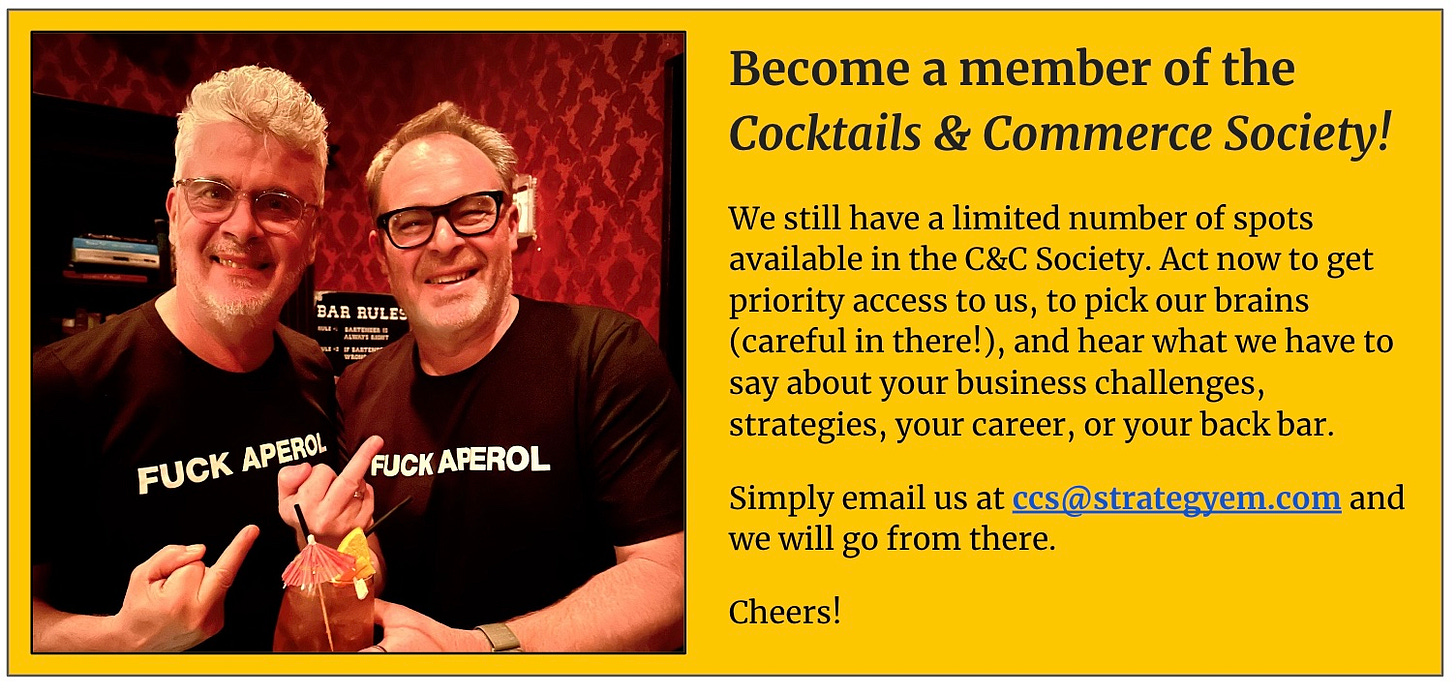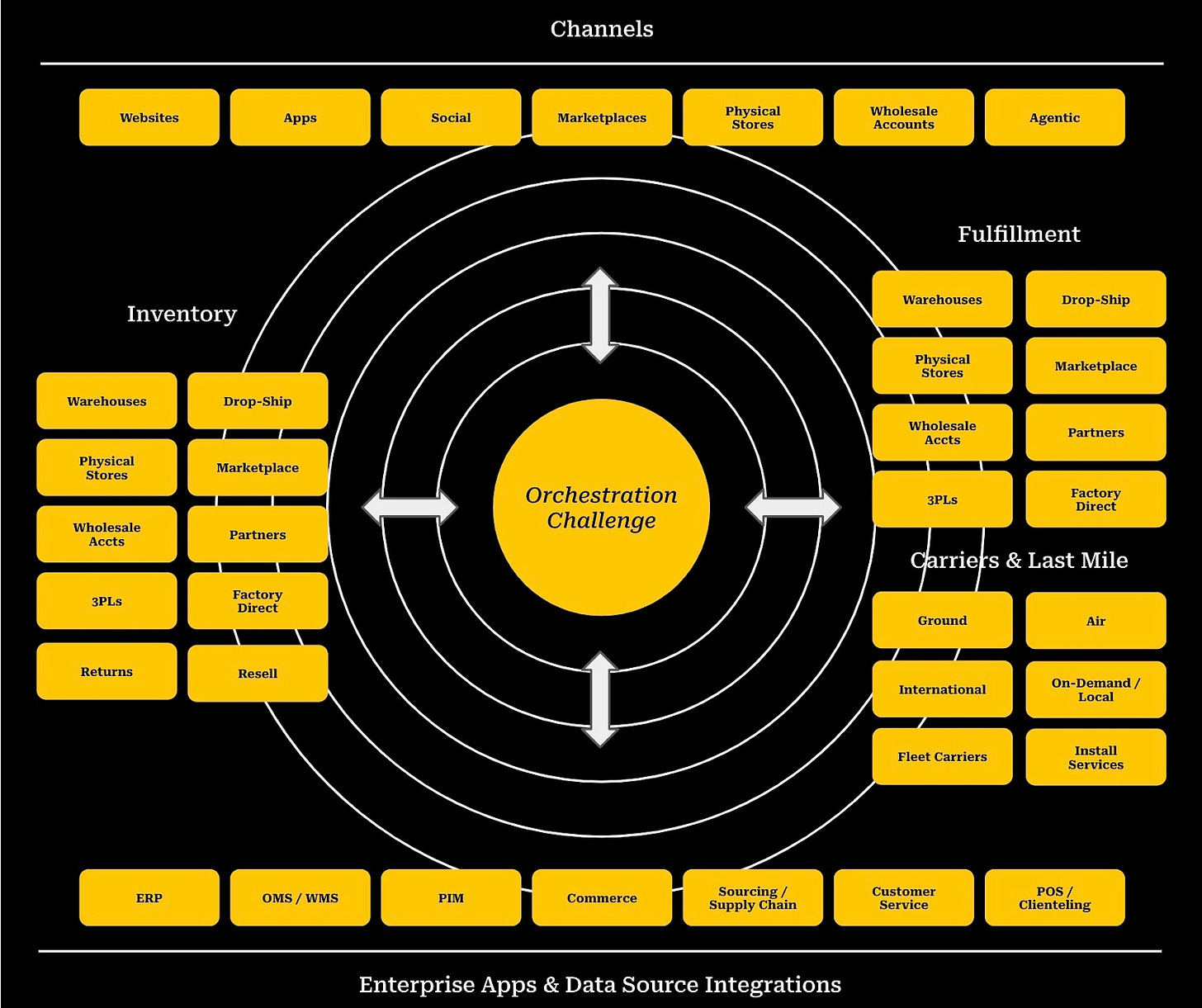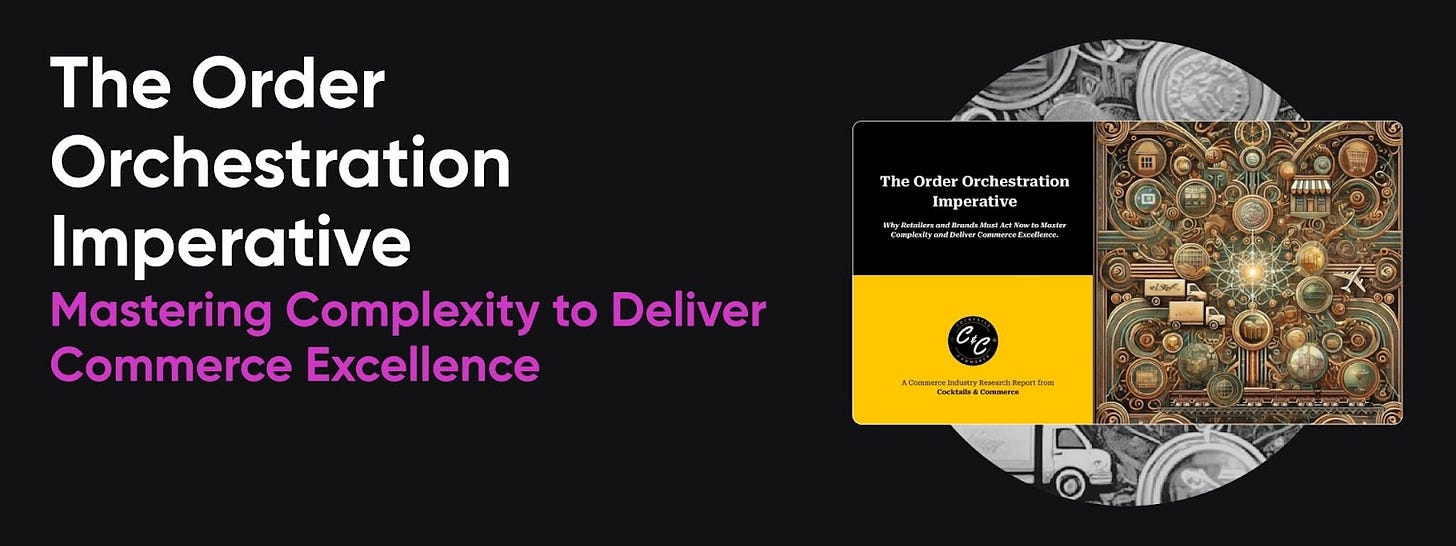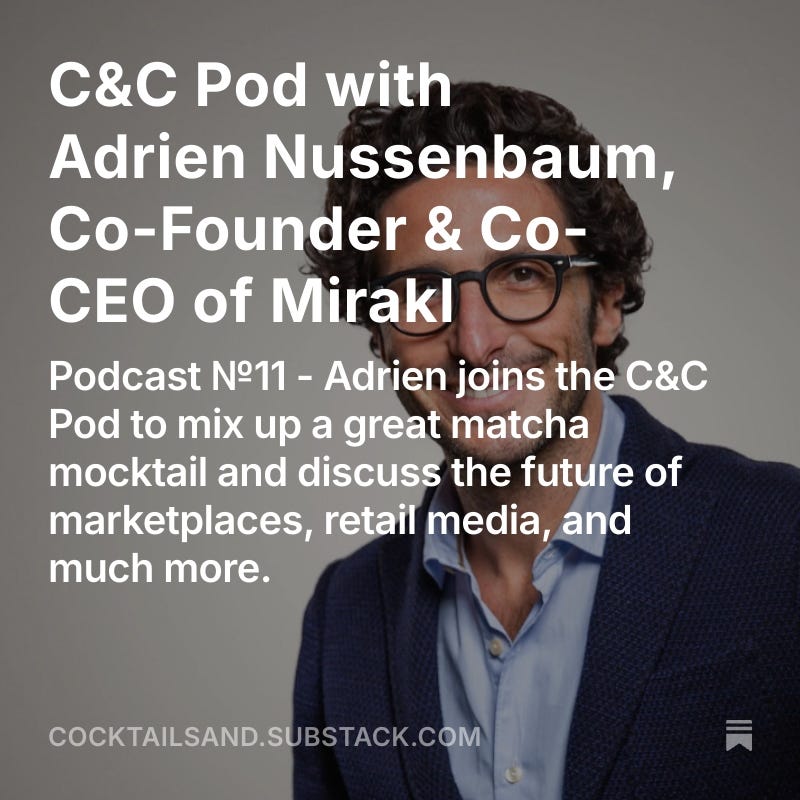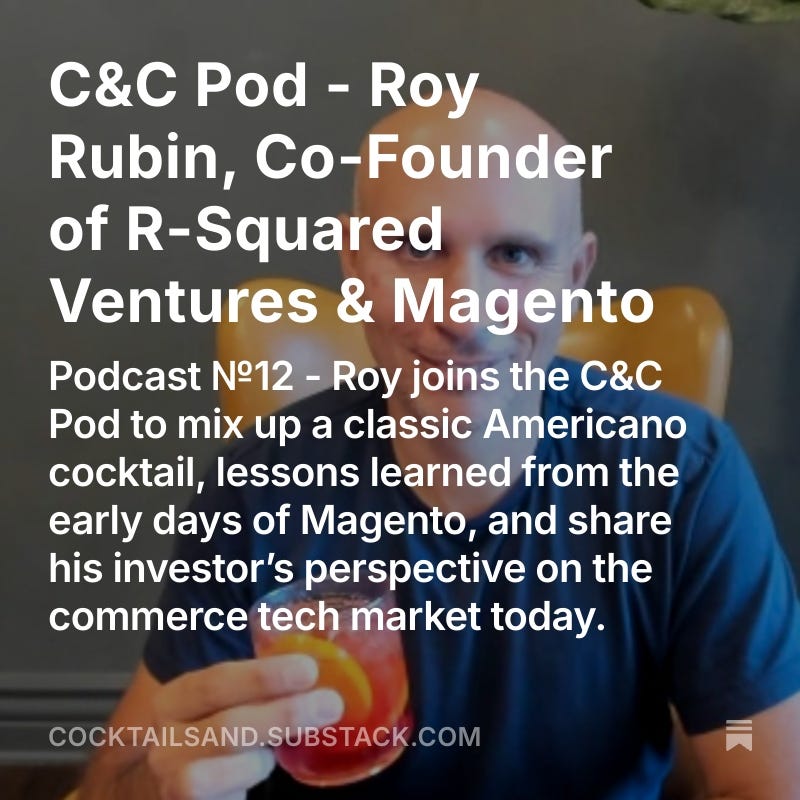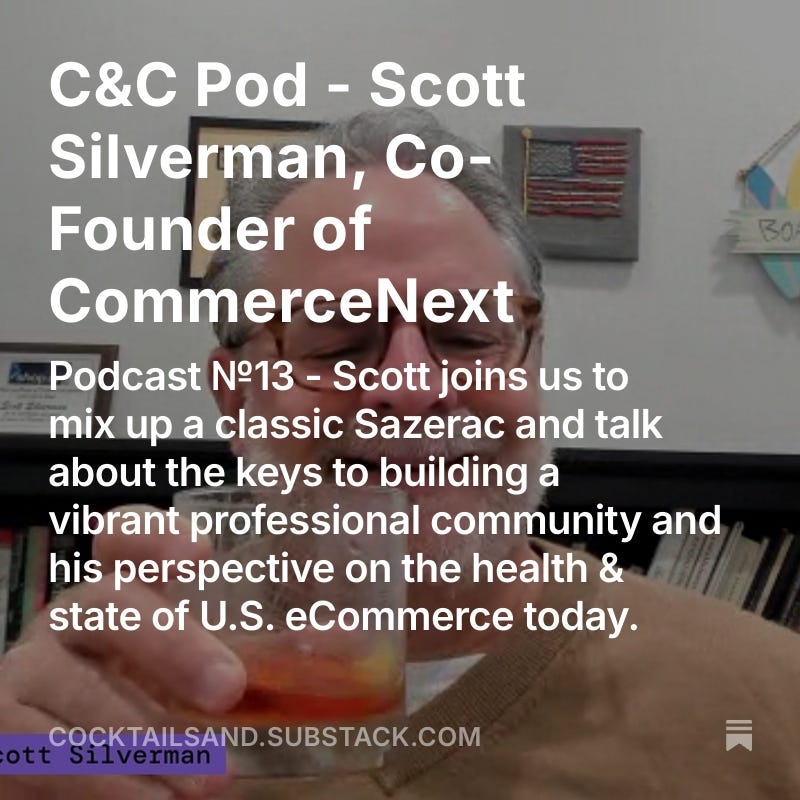The Order Orchestration Imperative, with a Sidecar
Issue №30 - We pair a century-old classic cocktail with a big topic, what we call ‘The Order Orchestration Imperative’ - and it's time for a new crop of OMS solutions to seize the opportunity.
Welcome to another edition of ‘Cocktails & Commerce’. For the past few months we have been immersed in an exploration of today’s operating environment for retailers and brands. In our view, the market has effectively reached ‘peak website’, with demand poised to be increasingly fragmented across social commerce, marketplaces, agentic and conversational experiences, as well as physical stores and owned websites. Meanwhile the fulfillment and supply-chain environment has become increasingly complex - with a combination of owned DCs, stores, dropship, off-shore on-demand, marketplace models, and opportunities for brands to tap into wholesale inventory out in the market owned by their retail partners. It is a complex problem to solve and calls for a new crop of OMS solutions to emerge with modern architectures and native AI to help retailers and brands optimize inventory turns, manage the complexity, and deliver on customer promises across this fragmenting demand landscape. We believe this category will be among the winners in the next wave of commerce tech investment.
This analysis is an excerpt from our first ‘Cocktails & Commerce’ research outlook. The full report is available from our friends at Fabric and to our amazing C&C Society Members. (See below if you are interested in becoming a CCS member!) And of course, we must always pair our analysis with a cocktail - and we’ve chosen the classic Sidecar - a cognac and orange liqueur wonder with a great backstory.
Cheers!
Cocktail: The Sidecar, a century of cognac, class, and a touch of danger
If the world of cocktails had a celebrity ball, the Sidecar would be up front, basking in the glow of an Art Deco chandelier, effortlessly oozing sophistication and elegance with a dangerous flair showing through. This legendary mix of cognac, curaçao triple sec, and lemon juice has been taking drinkers for a ride - figuratively and occasionally literally - for over a century.
The Sidecar first appeared in print in 1922 in books from two different London-based bartenders, Robert Vermeire and Harry McElhone. McElhone credited the Sidecar’s creation to a bartender named “John” at Henry’s Bar in Paris - which funny enough was across the street from the more famous Harry’s New York Bar (and no doubt was trying to lure drunken cocktail seekers across the street!). Per McElhone, John allegedly crafted it for an American soldier on leave from serving on the Western Front in WWI. However, as is often the case with cocktail origin stories, Vermeire claimed a different tale - placing the birth of the Sidecar in the south of France, at the Carlton Hotel in Cannes (a setting far more glamorous but a less interesting story!)
The Sidecar soon raced around the cafés of Paris and was discovered by bartender Malachi "Pat" McGarry, a known travel enthusiast, who took it to London and made it a signature cocktail at the well-heeled Buck's Club in London. That’s what put it on the global mixology map. The Sidecar soon exploded in popularity throughout the 1920s across Europe, and became popular in the speakeasies of New York during prohibition. And as with any great classic, variations abound. The traditional European spec calls for equal parts cognac, triple sec, and lemon juice, while the American take leans toward a more spirit-forward 2:1:1 ratio - a ratio in our opinion more adapted to modern palettes.
Though the drink was reportedly christened a Sidecar because it was potent enough to “take you for a ride,” it was considered the height of boozy sophistication. In fact, the Ritz Bar in Paris dazzled its privileged clientele by mixing a super blingy variation made with the Ritz's stash of precious vintage mid-nineteenth century cognac - from before the phylloxera epidemic forever changed the structure of grapes used for wine and brandy. The Ritz charged a then-astronomical sum of five U.S. dollars for that drink, the equivalent of about $85 bucks today. (Before tax and tip! Youza!)
The great sugar-rim debate
Many assume a Sidecar should come with a sugared rim, but the original did not add the sparkle and crunch on the rim, and mixology-purists are likely to scoff at it. It was not until sometime in the 1930s that the sugared-rim became a fixture of the cocktail in the U.S., possibly confused with or borrowed from the somewhat similar Brandy Crusta. Whether you opt for the frosted edge or go au naturel, it’s best to call out your preference before your bartender makes the decision for you. (Since you asked, we are of the au naturel crowd, since the added sugar takes the drink in a sweeter direction.)
Today, the Sidecar remains a staple of any serious classic cocktail menu, embodying the golden age of mixology with every citrusy, velvety sip. It’s the kind of drink that makes you straighten-up, imbue an air of mystery, and possibly ponder a last-minute trip to Paris. After all, some rides are worth taking.
Cheers!
Sidecar Cocktail Spec (Serves One)
1.5 oz (~45 ml) - Cognac (Pierre Ferrand 1840 recommended
.75 oz (~20 ml) - Orange liqueur (Cointreau or Pierre Ferrand Dry Curaçao recommended)
.75 oz (~20 ml) - Lemon juice, freshly squeezed
Garnish - Orange twist (Optional: Sugar rim)
The process:
(Optional, if desired: Coat the rim of a coupe glass with sugar and set aside. See note.)
Add the cognac, orange liqueur and lemon juice to a cocktail shaker. Add with ice and shake until well-chilled. Strain into the coupe glass. Express oils from orange twist over glass, then garnish. (Preparation time: 6 minutes.)
Notes:
The best way to coat a rim is to take the glass and hold it upside down, wet the lip with water or light syrup where you want the sugar and sprinkle the sugar on the dampened portion of the glass - still holding it upside down. Tap to release the excess from the glass.
Note: The below analysis is an excerpt from our first ‘Cocktails & Commerce’ industry outlook report. The full report is available for download from our friends at Fabric. We encourage you to download the full report for a deeper dive. (Registration required).
Analysis: The Order Orchestration Imperative
The modern retail landscape has never been more complex. Demand is no longer concentrated in a single digital sales channel - it’s fragmented across marketplaces, social platforms, brand-owned apps and sites, physical stores, and will soon see agentic and conversational experiences likely grow in importance. Fulfillment has followed suit, evolving into a sprawling network of distribution centers (DCs), stores, third-party logistics providers (3PLs), dropship networks, wholesale channels, and factory-direct models - while customers expect transparency, choice, and control over where and how they receive or pick-up their orders.
Retailers and brands that fail to adapt to this complexity are already struggling. Inventory misalignment leads to stockouts in high-demand channels while surplus inventory sits idle elsewhere. Fulfillment inefficiencies drive up costs, cut into already thin margins, and leave customers frustrated with missed promises. Legacy commerce and order management systems (OMS) weren’t built for this level of complexity and retailers and brands that continue relying on outdated, inadequate technology will be left behind as more agile competitors optimize dynamic fulfillment at scale.
The message is clear: retailers must evolve their approach to order fulfillment or risk falling behind - and the tech and solutions market must step up to meet the challenge. The solution? Modern order orchestration - an agile, real-time, event-driven, AI-enhanced approach to marshaling demand, surfacing inventory, and orchestrating orders across this ever increasing fragmented demand landscape.
The Challenge: Demand is fragmented, and fulfillment is complex
For years, a brand or retailer's eCommerce website was the focal point of digital strategy. Today, that model is already obsolete. We have now effectively reached ‘peak website’. The eCommerce websites of retailers and brands will in essence never be as important again as they were yesterday as demand increasingly fragments and consumers now discover and purchase products across an expanding range of touch-points - social commerce platforms, third-party marketplaces, direct-to-consumer (DTC) websites, in-store experiences, and soon likely agentic and conversational experiences.
Retailers can no longer dictate where and how customers shop - instead they need to be everywhere customers are. Consider the ongoing shifts happening today:
Marketplaces continue to dominate online commerce: 39% of all U.S. eCommerce transactions now occur through marketplaces, growing at well over 10% annually. If a retailer or brand isn’t optimizing for Amazon, Walmart, and other marketplace channels, it is losing significant revenue opportunities - and many should consider a marketplace model as well, to take advantage of the margin and dynamic assortment opportunities a marketplace model represents.
Social commerce is accelerating: Close to 10% of U.S. eCommerce transactions already happen through social platforms, with higher penetration across many global markets. A viral TikTok post can create instant demand, but if retailers or brands lack the orchestration to dynamically capitalize on available inventory across their network and fulfill it, they miss sales opportunities. Adapting assortments to signals in social channels is a competitive advantage, and presents a challenge for most American and European retailers and brands, while others - such as Temu, Shein, and Amazon capitalize.
Omnichannel and customer choice is the expectation: We all reccognize that consumers don’t think in terms of “channels”. They expect a seamless experience as they move between social discovery, marketplace purchases, brand-owned websites, and physical stores - with consistent inventory availability and choice of fulfillment options across them all. As customers shop and make decisions to buy, they expect to understand product availability and the breadth of fulfillment options. They want to understand what’s available, where. They want to understand the full range of shipping options - the tiers of service they qualify for and the costs. If a promise date is too long or too vague, they will hesitate - often failing to convert. Customers also want complete control - able to make changes even after the order is placed.
Agentic and conversational experiences are poised to have an impact: It is early to predict the pace of change that agentic and conversational shopping experiences powered by the likes of Google, OpenAI, Perplexity or Apple may have, but we can count on some percentage of demand flowing through these channels soon.
Retailers and brands that focus on website-first strategies or linear, static supply chains will increasingly struggle to keep up. Demand now exists across dozens of fast-moving, unpredictable digital and physical touchpoints.
Fulfillment has become a complex network, amplifying the challenge
As demand has become more fragmented, so has fulfillment. Gone are the days when a centralized warehouse or two could efficiently serve demand. Today’s fulfillment ecosystem includes:
Distribution Centers (DCs): The back-bone of retailers and brands fulfillment operations but costly to operate and slow to react to localized demand spikes.
In-Store Fulfillment (BOPIS, and Ship-from-Store): Retailers increasingly use stores as micro-fulfillment centers, but most lack the infrastructure to manage real-time routing, labor allocation, and fulfillment optimization.
3PLs and Dropship Networks: Retailers rely on third-party logistics providers and direct supplier fulfillment to expand assortment and reach, but coordination across these partners is a significant operational challenge. For retailers and brands, drop-ship and marketplace models where they don’t have to commit capital to inventory and receive a predictable commission offer massive advantages over traditional supply chains and owned inventory.
Factory-Direct and On-Demand Fulfillment: Shein, Temu, and Amazon are resetting expectations for rapid, low-cost delivery with direct-from-factory sourcing. Traditional retailers must rethink their supply chains to stay competitive.
Understanding the Orchestration Challenge
Retailers today must manage an increasingly complex fulfillment landscape, but legacy order management systems (OMS) weren’t designed for this level of scale and flexibility. Most existing solutions rely on batch-based updates, rigid rulesets, and siloed inventory data, making it nearly impossible to execute real-time fulfillment decisions. The core challenges of traditional, legacy approaches to order management and fulfillment in the face of these challenges include:
Disconnected, siloed inventory across many systems and sources: Many retailers still operate with siloed inventory pools across DCs, stores, and 3PLs, preventing a single, real-time view of stock availability.
Rigid order management and routing rules: Traditional OMS solutions rely on predefined fulfillment rules rather than dynamically optimizing order allocation based on real-time cost and availability.
Inventory visibility is inconsistent: When demand is fragmented across multiple channels, real-time inventory accuracy is critical. Yet most retailers still rely on batch updates, leading to overselling in one channel while stock sits idle in another.
Fulfillment is inefficient: Many retailers still use static, pre-set order routing rules rather than dynamically optimizing fulfillment based on real-time cost, availability, and delivery speed. This leads to inflated fulfillment costs and suboptimal customer experiences.
Costs are rising and efficiency and productivity are paramount: In-store fulfillment labor, 3PL costs, and complex multi-node logistics require advanced coordination. Without orchestration, inefficiencies grow, and profitability shrinks.
Customer experience is inconsistent: Consumers expect accurate promise dates, real-time fulfillment choices, and post-purchase flexibility. Retailers that lack orchestration capabilities struggle to meet these expectations, leading to lower conversion rates and increased customer churn.
Lack of agility and scalability with rigid, expensive, and data-intensive systems: Many legacy order management solutions are not only outdated but also prohibitively expensive to customize for modern needs. Their monolithic architectures make even small updates or integrations a costly and time-consuming endeavor - requiring downtime and regression testing to update. In a world where agility and speed are paramount, this rigidity becomes a competitive disadvantage.
Retailers need a new approach—one that synchronizes demand and fulfillment in real time, optimizes inventory utilization, and ensures customer expectations are met profitably. This is a compelling and distinctly complex challenge to solve, but a critical one as brands and retailers move forward and serve customers efficiently and effectively in the new era while maximizing inventory turns, optimizing logistics, and improving margins through operational effectiveness and automation.
The Order Orchestration Challenge Illustrated
Order Orchestration, Redefined
Modern order orchestration solves the challenges legacy OMS systems cannot. It acts as the connective tissue between demand channels, inventory locations, and fulfillment nodes—ensuring every order is optimized in real time. Unlike traditional OMS platforms that process orders in isolation, order orchestration enables:
A unified view of inventory: A single, real-time inventory system spanning DCs, stores, dropship partners, and 3PLs ensures accurate availability across all sales channels.
Optimize inventory utilization: Adapt to shifts in demand, stock shortages/overages, or unexpected disruptions.
Calculate and surface promise dates and fulfillment options: Provide the customer with all their options, costs, and available promise dates within the shopping experience.
Dynamic fulfillment optimization: AI-driven routing selects the most cost-effective and fastest fulfillment location for every order, reducing costs while maintaining delivery speed.
Real-time sourcing decisions and quality assurance: Orchestration can automatically shift order sourcing based on demand fluctuations, supplier constraints, supplier performance, and operational disruptions.
Enhanced consumer experience: Beyond accurate fulfillment options at checkout, real-time tracking, and post-purchase flexibility.
This isn’t just about incremental improvements—it’s about fundamentally redefining how retailers manage demand and fulfillment.
The business case for Order Orchestration and how the tech community can capitalize on the urgency
Retailers and brands facing this increasing complexity will struggle to adapt their operational capabilities, supply-chains, and delight their customers without a boost from technology. Meanwhile as we reach peak website, further investment in front-end eCommerce optimizations will have a decreasing returns - in-part due to the fact we have thirty-years of commerce experience optimization behind us and the experience and capabilities of websites have normalized and commoditized. (And yes, this in part can explain at least some of the slow-down in commerce tech investment.) We expect tech investment to shift to other areas of the digital commerce stack, and the broad order management category is in our view among them. (Others include product discovery/conversational-experiences and commerce process automation, but that’s for a different article.)
The business case for retailers and brands will be one grounded in the efficiencies to be gained in adopting modern order orchestration capabilities. Those include improved inventory turns and inventory utilization with flexible and dynamic assortments and inventory from a variety of drop-ship and marketplace inventory, ability to serve dynamic demand channels including social commerce and marketplaces through a diverse and flexible supply chain, and operational efficiencies inside their own fulfillment and ship-from-store operations.
And of course there are topline metrics to consider as well, conversion is directly impacted by the availability of the product, ability to promise it to customers in a timely time-frame, and give them control over how they want that product delivered to them. As dropship and other fulfillment models increase, this becomes key to driving top-line growth. And in terms of future-proofing, modern, orchestration solutions position retailers and brands to be proactive with their assortments - adapting more dynamically to demand and shifts in consumer behavior, while unlocking growth opportunities that were previously unattainable.
A collective call-to-arms: The time for a modern order orchestration solution to emerge is now
Retailers and brands that fail to modernize their fulfillment strategy will face increasing inefficiencies, shrinking margins, and lost customer trust. As consumer expectations evolve and competitors invest in real-time orchestration, those clinging to legacy systems will be left behind. Merchants large and small will need effective solutions that leverage an event-based architecture - layering into and complimenting existing commerce and operational tech stacks - including ERPs, existing OMSs and WMSs, commerce platforms, marketplace solutions, et al - without complex and data-intensive integrations. These solutions must be API-first and relatively easy to implement and configure, and of course much utilize AI - of all kinds - to enable optimization, automation, and ease of use and business controls without the burden of specialized skills among their customers. They must be resilient, scalable and adaptive to ensure uptime, performance and operational continuity during spikes and disruptions - within the fulfillment network or surges in demand.
The future of retail belongs to those who can dynamically align demand and fulfillment in real time, and the vendors who can support that will benefit from the next wave of commerce tech investment. This capability will likely not emerge from legacy OMS vendors who are burdened with both decades old technology stacks and a significant install base of existing customers - but rather will emerge from a new crop of vendors leveraging modern cloud and event-driven architectures - together with native AI - to solve for this complex challenge.
To read more and dive deeper in the Order Orchestration Imperative, download the full report now from our friends at Fabric.
ICYMI - Listen to our latest podcasts!
Great guests, and great conversations over both mocktails and cocktails!
If you are looking for Brian online, you can find him here, and here. And find Bill here and here.
Be well, be safe, and here is to good business! Cheers! - Brian & Bill
Cocktails & Commerce™ is a wholly owned subsidiary of StrategyēM, LLC.





